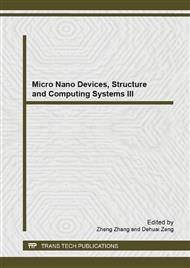[1]
Zheng Weijie,Xu Wenyuan.Harmonically coupled linear model for harmonic analysis of TCR [J] .Proceedings of the CSEE,2008,28 (1) :59-64(in Chinese).
Google Scholar
[2]
Zheng Weijie,Sun Yuanyuan,Xu Wenyuan.Harmonic power flow calculation using linearly coupled admittance matrix model for nonlinear elements[J].Proceedings of the CSEE,2008,28(10):117-122(in Chinese).
Google Scholar
[3]
Y. W. Li , D. M. Vilathgamuwa and P. C. Loh Microgrid power quality enhancement using a three-phase four-wire grid-interfacing compensator, IEEE Trans. Ind. Appl., vol. 41, no. 6, pp.1707-1719 (2005).
DOI: 10.1109/tia.2005.858262
Google Scholar
[4]
Task Force on Harmonics Modeling and Simulation. Modeling and simulation of the propagation of harmonics in electric power networks, part I: concepts, models and simulation techniques [J]. IEEE Transactions on Power Delivery, 1996, 11(1): 452-465.
DOI: 10.1109/61.484130
Google Scholar
[5]
H. Akagi , H. Fujita and K. Wada A shunt active filter based on voltage detection for harmonic termination of a radial power distribution line, IEEE Trans. Ind. Appl., vol. 35, no. 3, pp.638-645 (1999).
DOI: 10.1109/28.767015
Google Scholar
[6]
Wilsun Xu.Component modeling issues for power quality assessment [J] .IEEE Power Engineering Review,2001,21 (11) :12-15,17.
Google Scholar
[7]
P. Jintakosonwit , H. Akagi , H. Fujita and S. Ogasawara Implementation and performance of automatic gain adjustment in a shunt-active filter for harmonic damping throughout a power distribution system, IEEE Trans. Power Electron., vol. 17, no. 3, pp.438-447 (2002).
DOI: 10.1109/tpel.2002.1004252
Google Scholar
[8]
Xu W,Drakos J E, Mansour Y,et al.A three-phase converter model for harmonic analysis of HVDC systems[J].IEEE Trans.on Power Delivery,1994,9 (3):1724-1731.
DOI: 10.1109/61.311188
Google Scholar
[9]
L. Asiminoaei , F. Blaabjerg and S. Hansen Evaluation of harmonic detection methods for active power filter applications, Proc. IEEE APEC, pp.635-641 (2005).
DOI: 10.1109/apec.2005.1453014
Google Scholar
[10]
Carbone R,De Rosa F,Langella R,et al.A new approach to model AC/DC/AC conversion systems[C].IEEE Power Engineering Soc.Summer Meeting,Vancouver,Canada,(2001).
DOI: 10.1109/pess.2001.970025
Google Scholar
[11]
Task Force on Harmonics Modeling and Simulation. Characteristics and modeling of harmonic sources power electronic devices [J]. IEEE Transactions on Power Delivery, 2001, 16(4): 791-800.
DOI: 10.1109/61.956771
Google Scholar
[12]
Zheng Weijie,Zhou Xiaoxin.Equivalent electro-magnetic transient model based on dynamic reluctance for magnetically controlled shunt reactor [J] .Proceedings of the CSEE (in Chinese), 2011,31(19):1-7.
Google Scholar
[13]
Yacamini R.Power system harmonics: Part 4 interharmonics [J] .IEE Power Eng.J., 1996,8:185-193.
Google Scholar
[14]
ZHENG Weijie, ZHOU Xiaoxin, Dynamic Adaptive Inverse Control Algorithm Magnetically Controlled Shunt Reactor Based on Time Varying System Parameters Tracing[J].Proceedings of the CSEE(in Chinese), 2011,31(19):1-7.
Google Scholar
[15]
H. Fujita and H. Akagi Voltage regulation performance of a shunt active filter intended for installation on a power distribution system, IEEE Trans. Power Electron., vol. 22, no. 3, pp.1046-1053 (2007).
DOI: 10.1109/tpel.2007.897115
Google Scholar
[16]
Zheng Weijie,Stability effects research of stepped controlled shunt reactor inner faults to power grid [C],China International Conference on Electricity Distribution (CICED2012), September 2012 Shanghai China. P3-65.
DOI: 10.1109/ciced.2012.6508525
Google Scholar
[17]
P. Mattavelli Synchronous-frame harmonic control for high-performance ac power supplies, IEEE Trans. Ind. Appl., vol. 37, no. 3, pp.864-872 (2001).
DOI: 10.1109/28.924769
Google Scholar
[18]
C. Lascu , L. Asiminoaei , L. Boldea and F. Blaabjerg Frequency response analysis of current controllers for selective harmonic compensation in active power filters, IEEE Trans. Ind. Electron., vol. 56, no. 2, pp.337-347 (2009).
DOI: 10.1109/tie.2008.2006953
Google Scholar
[19]
Zheng Weijie,The dynamic characteristics research of Extra/Ultra high voltage magnetic controlled shunt reactor [C] ,CIGRE,Paris,France, August 2012. A2-302.
Google Scholar
[20]
J. He , S. Munir and Y. W. Li Opportunities for power quality improvement through DG–grid interfacing converters, Conf. Rec. IEEE IPEC, pp.1657-1664 (2010).
DOI: 10.1109/ipec.2010.5542170
Google Scholar


